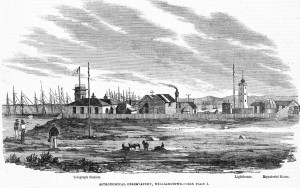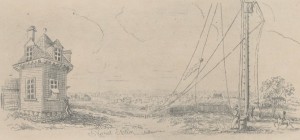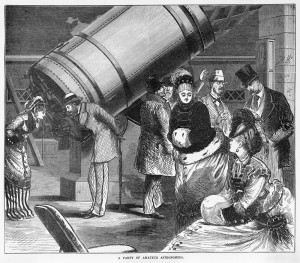In 1853 Melbourne was developing rapidly and the need for consistent, accurate time across the burgeoning colony saw the first observatory built in Williamstown. Time was communicated… ‘by dropping a ball on the Williamstown Flagstaff at one o’clock…This signal was watched from the Melbourne Flagstaff, about 4.5 miles distant, by aid of telescope, and a ball was dropped there also’ (1).
Astronomical Observatory, Williamstown, IMP15/11/62/9
Signal Station, Melbourne, H15274/2
By 1854, the lighthouse at Point Gellibrand was giving time signals to ships in Hobsons Bay (2). This was done by ‘eclipsing the light of the lighthouse every night at two minutes to eight and suddenly exposing it at eight o’clock'(3).
In 1863 a new Melbourne Observatory was built in the Botanic Gardens. ‘The intricate timing instruments of the Observatory, kept accurate by daily calibration with the stars, were connected by telegraphic wire with the clock displayed in Bourke Street’ (4). The Great Melbourne Telescope was installed in 1869 at the Observatory where ‘the astronomers had to painstakingly observe faint nebulae and distant galaxies, then produce pencil sketches of their observations’ (5).
The great Melbourne telescope, IMP22/05/68/72
A party of amateur astronomers, A/S11/07/74/45
The Melbourne Observatory closed in 1944 and the timekeeping responsibilities were taken over by the Postmaster-General’s Department (6). The Great Melbourne Telescope was transferred to the Academy of Science at Mt Stromlo in Canberra in the 1950s.
The Library holds many online astronomy resources, including a Miniature celestial globe reputed to have been used by Captain Cook and pages of the star map Atlas coelestis, as well as the Sir Isaac Newton pamphlet Spiritual astronomy, our solar system from a spiritual standpoint.
Written by Paul Dee,
Librarian, Australian History and Literature






It was not until the Flagstaff Observatory was set up by Georg Neumayer in 1958 that a telescope was used to observe the time ball drop at Williamstown. From 1854, time balls in the city were dropped by telegraphic signal from Williamstown Observatory using the first telegraph line in the southern hemisphere.
The new Melbourne Observatory of 1863 was definitely not built in the Botanic Gardens but was on land excised from Government House Reserve.at the direction of Governor Sir Henry Barkly.
The last official astronomical observation at Melbourne Observatory was around September 1945. The Great Melbourne Telescope was moved to the Commonwealth Solar Observatory at Mt Stromlo near Canberra in 1945. Its damaged stone north pier from Melbourne was used as the foundation stone of the Academy of Science building in Canberra in the 1950s.
The “party of amateur astronomers” in the illustration actually shows astronomers Ellery and Baracchi entertaining the Governor and party from the adjacent Government House.
The Great Melbourne Telescope itself is now undergoing authentic heritage restoration at Scienceworks.